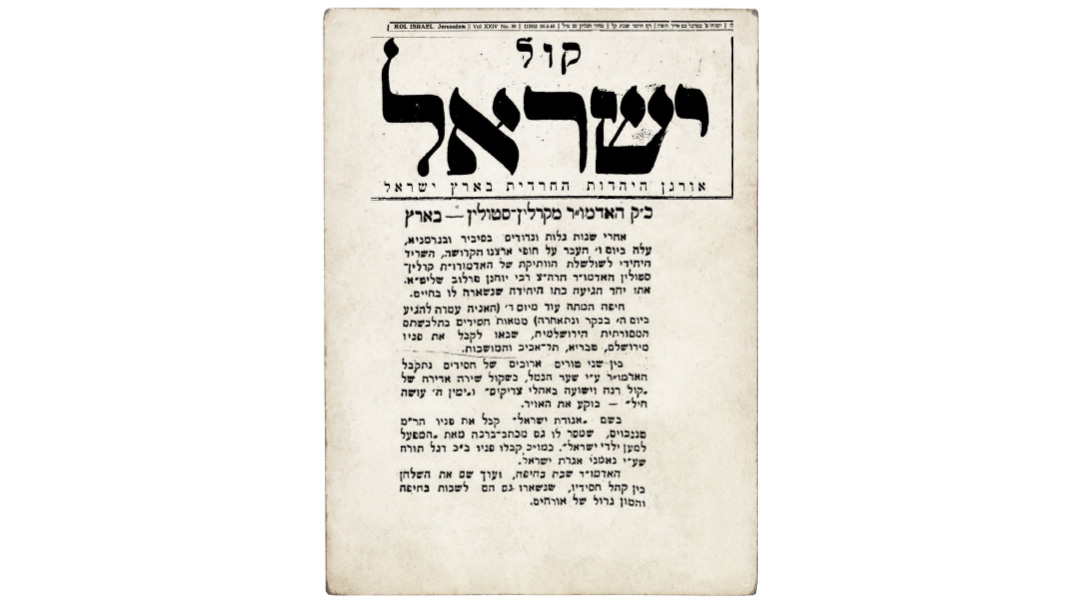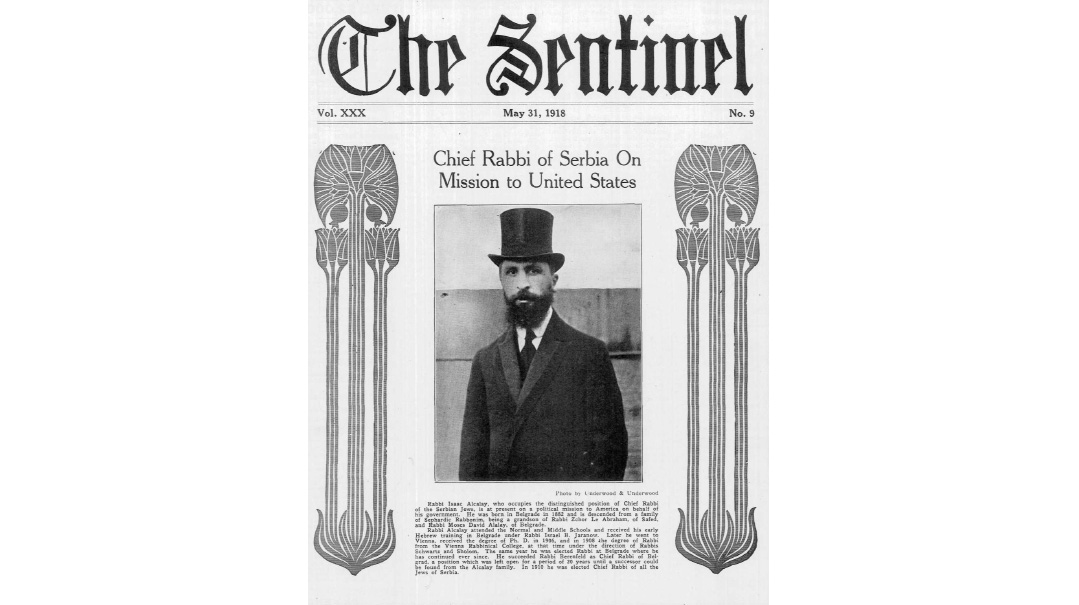Stolin’s Sole Survivor
| December 13, 2022The youngest of the ten children of Rav Yisrael Perlow, the Yenuka of Stolin, Rav Yochanan was now the sole survivor

Title: Stolin's Sole Survivor
Location: Haifa
Document: Kol Yisrael
Time: 1946
ON May 24, 1946, the SS Andre Lebon was greeted at the port of Haifa by a large crowd that included official representatives of the Yishuv, there to receive the heroine of the Warsaw Ghetto uprising, Zivia Lubetkin. There were also throngs of chassidim anticipating the arrival of another famous passenger — the Stoliner Rebbe, Rav Yochanan Perlow.
It was a poignant welcome. The youngest of the ten children of Rav Yisrael Perlow, the Yenuka of Stolin, Rav Yochanan was now the sole survivor. Almost all his siblings and their families were killed in the Holocaust, including the two primary Rebbes of the Karlin-Stolin community, Rav Avraham Elimelech and Rav Moshe. The last surviving brother had been Rav Yaakov Chaim, the Stolin Rebbe who had immigrated to the United States in 1923 and established a small court in Williamsburg. Just two weeks earlier, the very day that Rav Yochanan had boarded the SS Andre Lebon at Marseille, Rav Yaakov Chaim had passed away in Detroit while visiting his chassidim there.
To compound the tragic scenario, his brother in the US had been childless. Rav Yochanan’s wife Margalit and elder daughter Sarah had succumbed to food poisoning in their wartime exile in the Soviet interior. Rav Yochanan arrived with his daughter Faigaleh and no one else. Bereft of his family, community, and worldly possessions, he was all that remained of the storied Karlin-Stolin dynasty.
Four sons had succeeded the Yenuka of Stolin upon his passing in 1921: Rav Avraham Elimelech in Karlin, Rav Moshe in Stolin, Rav Yaakov Chaim in Brooklyn, and Rav Yochanan in Lutzk.
His older brother Rav Avraham Elimelech opened a yeshivah based in Lunintz and hired Rav Elazar Menachem Shach as rosh yeshivah. He paid four visits to Eretz Yisrael in the interwar period, the last of which came in the summer of 1939. Though encouraged by his followers to stay in Palestine, he boarded a ship in Haifa on August 29, 1939. Three days later, World War II commenced, and he was martyred together with his beloved chassidim.
Rav Yochanan too had visited the Holy Land in 1937 and opened a small yeshivah in Lutzk shortly before the war. With the Nazi invasion of the Soviet Union on June 22, 1941, he fled east with his family, and he advised others to do likewise. He spent the war years in Frunze (now Bishkek), Kyrgyzstan, losing his wife and daughter. After the war, he ended up in the displaced persons camp at Feldafing in US-occupied Germany.
Attempting to remain unobtrusive in the camp, he was recognized by Lieutenant Meyer Birnbaum, who was directed by Mike Tress to expose the identity of the surviving Stoliner Rebbe. When asked if he was indeed the Stoliner Rebbe, he was silent. When further pressed if his silence could be interpreted as an acknowledgment, Rav Yochanan sighed, “I was the Stoliner Rebbe.”
But as the sole survivor, a rebbe he was destined to be. When the ship docked in Haifa, a new era was dawning for the Karlin dynasty. He was no longer the Lutzker Rebbe, but would now be known as the Stolin-Karlin Rebbe (or Karlin-Stolin, or Karlin or Stolin). He painstakingly went about rebuilding the shattered community, and became the first ever chassidic rebbe to settle in Haifa.
For various reasons, he left for the United States in January 1948, settling in Williamsburg. He visited Israel once more shortly before his passing, and maintained an active and steady correspondence with his followers there. The tiny Karlin community in the United States at the time of his arrival numbered around 200 chassidim. Rav Yochanan established a yeshivah, and laid the groundwork for the community’s growth.
It didn’t last long. In 1955, he suffered a stroke and passed away shortly afterwards. Upon his passing, the future of Karlin was once again in doubt, but as it had so often in the past, it successfully rebounded, primarily under the leadership of Rav Yochanan’s grandson, the current Rebbe, Rav Baruch Meir Yaakov Shochet. It continues to flourish on both continents in the 21st century.
The Rebbe the Violinist
As were his ancestors, Rav Yochanan was both a composer and musician, playing the violin and cello. He even had a relationship with a Polish musician in Lutzk named Witold Pomienko, who spoke fluent Yiddish. When the Rebbe was in Feldafing after the war, he asked Lt. Birnbaum if he could obtain a violin for him. When he settled in Williamsburg, the chazzan in his shul in Williamsburg was the legendary composer Yom Tov Ehrlich, whom the Rebbe encouraged to produce and record his music.
Buried and Reburied
A dispute arose between his followers in America and in Israel regarding his final resting place. Initially he was buried in New Jersey, but after more than a year of wrangling, it was decided to transfer his body to Israel. A large crowd assembled for the levayah, and the reburial took place in the old cemetery of Teveria, where Rav Yochanan was buried next to Rav Menachem Mendel of Vitebsk.
The Stoliner Rebbe’s yahrtzeit is 21 Kislev.
This column is based on the research of Professor Benny Brown.
(Originally featured in Mishpacha, Issue 940)
Oops! We could not locate your form.







